Calf Injury for Runners: How to Assess, Help & Prevent
Calf pain after running is common. Learn how you can fix tight and sore muscles after running and prevent serious injury with calf exercises.
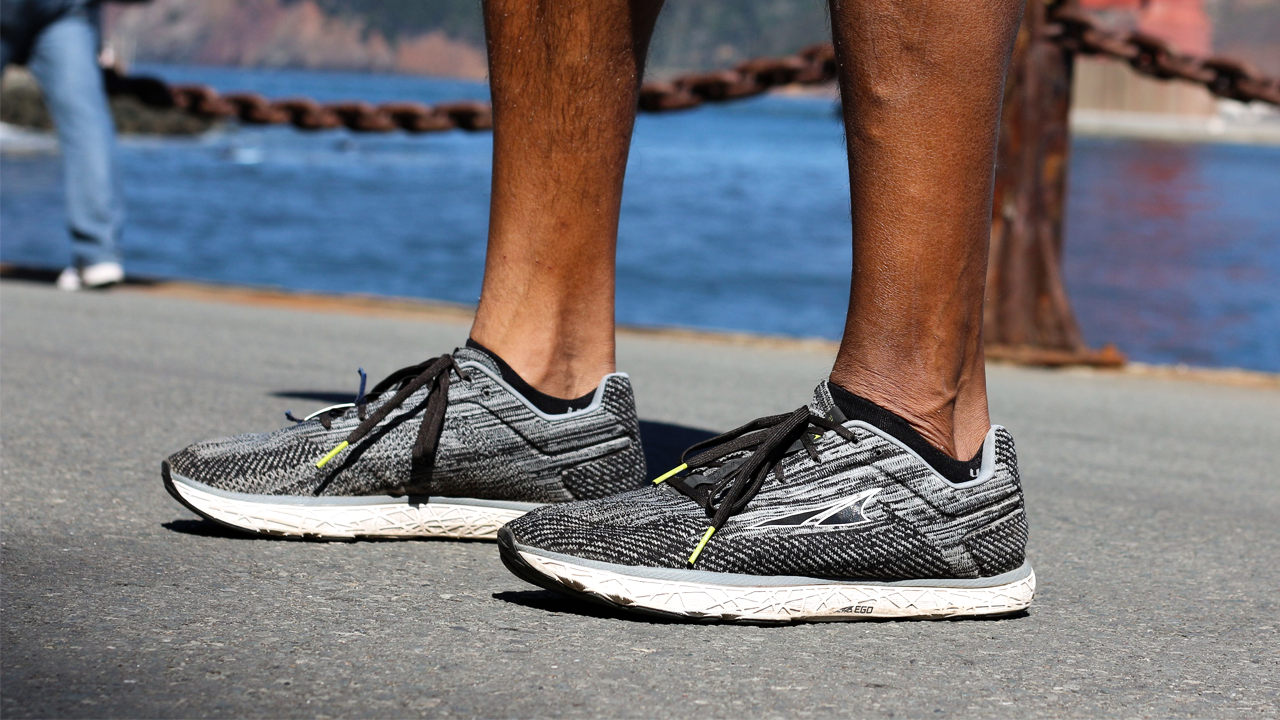
Calf injury in runners…what an exhausted, yet seemingly unresolved topic. Calf pain after running is a running injury nearly every athlete has experienced. As runners, it doesn’t take long to realize that your calves are invaluable to you!
Whether you have calf pain when running or after running, there are things you can do to help. Ideally, you can address calf tightness before it develops into pain or an injury—but regardless of your situation, we’re here to help.
Let’s look at how to best take care of them for optimal performance.
Calf Pain When Running
Whether you’re a seasoned runner or lacing up for the first time, understanding, identifying, and preventing calf pain is crucial to maintaining a healthy and sustainable running practice.
Calf pain can manifest in various forms—it might be a sharp, stabbing pain during your run, a dull ache afterward, or a persistent soreness. The pain might localize in different areas of the calf, such as near the knee, above the ankle, or on the inner or outer calf, each potentially indicating different underlying issues.
For instance, pain around the ankle might suggest issues with foot collapse during footstrike, while pain in the central back region could indicate an over-reliance on your toes during running, leading to excessive calf strain.
In the next section, we'll cover how to identify where the pain is to help you begin the steps to resolution. However, your calf pain when running could be a manifestation of other problems, too.
Calf Pain Diagnosis and Treatment Options
Self-Assessment
Understanding the nature and severity of your calf pain is the first step in addressing it effectively. Here’s how you can assess your calf pain at home:
1. Check for Tenderness:
- Locate the Pain: Gently press along different areas of your calf to identify where the pain is most intense.
- Assess Severity: Determine if the tenderness is mild, moderate, or severe. Mild tenderness may be uncomfortable but not debilitating, while severe tenderness can indicate a more serious injury.
2. Look for Swelling:
- Visual Inspection: Compare both calves to see if there’s any noticeable swelling or asymmetry.
- Touch: Gently press on the swollen area. If it feels puffy or leaves an indentation (pitting edema), this could be a sign of a significant injury or inflammation.
3. Test Range of Motion:
- Ankle Flexibility: Sit down with your legs extended. Try to point your toes (plantar flexion) and then pull them back towards your shin (dorsiflexion). Compare the range of motion with the unaffected leg.
- Pain During Movement: Note if any of these movements cause pain or discomfort. Limited range of motion and pain can indicate tightness, strain, or a tear.
4. Monitor Pain Levels:
- Daily Pain Scale: Use a 1-10 scale to rate your pain each day. This can help track progress or worsening symptoms.
- Pain Triggers: Identify activities or movements that exacerbate the pain, such as running, walking, or even resting.
When to See a Professional
While self-assessment can provide valuable insights, certain signs and symptoms require professional evaluation:
1. Persistent Pain:
- Duration: If your calf pain persists for more than a week despite rest and self-care, it’s time to see a healthcare professional.
- Worsening Pain: If the pain intensifies or spreads to other parts of the leg, seek immediate medical advice.
2. Severe Symptoms:
- Inability to Walk: If you cannot bear weight on the affected leg, or walking is extremely painful, consult a professional immediately.
- Visible Deformity: Any noticeable lumps, dents, or severe swelling should be evaluated by a healthcare provider.
3. Associated Symptoms:
- Fever: If you have a fever along with calf pain, it could indicate an infection.
- Redness and Warmth: Red, warm, and swollen calves might signal a blood clot or deep vein thrombosis (DVT), which requires urgent medical attention.
4. No Improvement with Self-Care:
- Lack of Progress: If there is no improvement after a few days of rest, ice, compression, and elevation (RICE), see a professional.
- Recurring Pain: Pain that goes away and then returns could indicate an underlying issue that needs professional treatment.
Treatment Modalities
Once you’ve identified the severity of your calf pain and consulted a professional if necessary, various treatment options can aid in recovery:
1. Physical Therapy:
- Personalized Exercises: A physical therapist can develop a tailored exercise program to strengthen the calf muscles, improve flexibility, and promote healing.
- Manual Therapy: Techniques like deep tissue massage and mobilization can relieve pain and improve function.
2. Massage Therapy:
- Deep Tissue Massage: Helps to break down scar tissue, improve blood flow, and alleviate muscle knots.
- Myofascial Release: Focuses on relieving tension in the fascia, the connective tissue surrounding muscles, which can help reduce pain and improve mobility.
3. Ultrasound Therapy:
- Healing Enhancement: Uses sound waves to promote tissue healing by increasing blood flow and reducing inflammation.
- Pain Relief: Can be particularly effective for chronic conditions by providing deep heating to tissues, which enhances the healing process.
4. Other Treatments:
- Cryotherapy: Applying ice packs to reduce inflammation and numb the pain.
- Compression: Wearing compression sleeves or wraps to reduce swelling and support the calf muscles.
- Electrical Stimulation: Using TENS (transcutaneous electrical nerve stimulation) units to provide pain relief and enhance muscle function.
The Role of Nutrition and Hydration
Your muscles, including your calves, require adequate nutrition and hydration to function optimally and recover post-exercise. Ensuring a balanced intake of macronutrients (proteins, fats, and carbohydrates) and staying hydrated can mitigate issues like muscle cramps and facilitate better recovery, reducing the likelihood of calf pain.
Sleep and Recovery
Adequate sleep and mindful recovery practices are non-negotiable for any runner. Sleep facilitates muscle repair and recovery, while adopting practices like stretching, foam rolling, and perhaps incorporating yoga can enhance flexibility and mitigate the risk of injuries and pain.
Injury Prevention Strategies
Preventing calf pain involves a holistic approach, including:
- Proper Form: Ensuring you maintain proper running form to avoid undue stress on the calves.
- Strengthening Exercises: Engaging in exercises that strengthen the calves, ankles, and surrounding muscles to provide better support during runs.
- Flexibility: Adopting a routine that enhances the flexibility of the calf muscles, reducing the risk of strains.
- Wearing Appropriate Footwear: Ensuring that your running shoes are in good condition, offer adequate support, and are suitable for your running style.
Why Do My Calves Hurt When I Run?
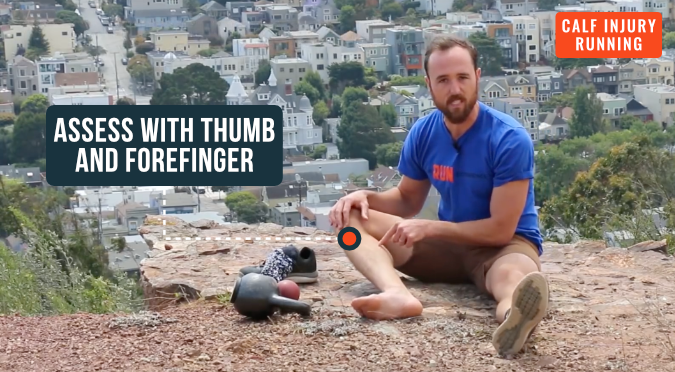
We get it all the time…”I have soreness in my lower legs!” “My ankle’s swollen!”
When it comes to assessing a calf muscle injury in runners, you’ve GOT to be specific. If we can’t identify the source of the pain and which muscles are tight, we can’t properly “fix” and then prevent future injuries.
Let’s first figure out where the pain is:
- Is it up near the knee?
- Is it down above the ankle, perhaps near the achilles’ tendon?
- Is it on the outer lateral aspect?
- Is it outer calf pain?
- Is it just a sore calf muscle, or is there acute pain?
- Is it on the inside, closer to the shin bone?
- Or is it maybe not even a calf injury at all? Is it something related to another area of the leg? A shin splint?
Once we’ve identified which quadrant the pain is inhabiting, we can throw around some potential causes.
For example, if the pain is around the sides of the ankle, it could be an issue of foot collapse in the footstrike.
If the pain is more central at the back, near the achilles, or just below the largest part of the calf, you could be putting most of your weight on your toes when you run–the heels of your running shoes maybe not even hitting the ground at all. The result? Stiffness in the front of the ankle and REALLY tight calves.
The final step:
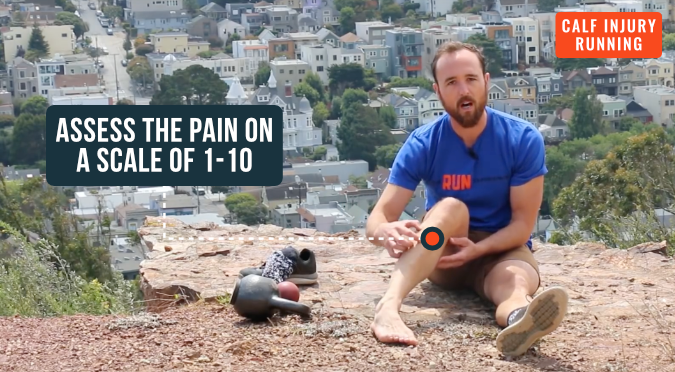
Gauge the level of pain.
A basic 1-10 scale will do.
The more acute, unbearable pain will fall closer to 10, and the more moderate “naggy” types of sore calves will fall somewhere between 1 and 4.
The intensity of the pain will be an indication of how to properly address the injury. It could be as simple as making an adjustment in your foot strike or as complicated as incorporating a new mobility routine, focused rest & repair.
Do You Have Tight Calves From Running?
Tight calves from running aren’t always painful—but they can sometimes lead to pain down the road. It’s best to address calf tightness after running immediately.
That might mean using strengthening, stretching, and foam rolling following a run, and it might mean following a regular protocol to mitigate tightness.
Don’t let tight calves catch up to you. Deal with them quickly to prevent calf pain and injury.
Should I Run With Calf Pain?
Ah, that’s a question we get from runners with just about every injury.
“Can I/should I run with calf pain?”
Well, it depends on the level of pain. Is it affecting your running form, pace, and performance? If so, it’s probably best to limit running (read: don’t stop) while you take care of your upper or lower calf pain.
Sometimes, easy running can help loosen up the responsible muscles and provide relief. However, you need a more comprehensive plan that includes strengthening, stretching, and massaging.
If you still want to run with calf pain, ask yourself a few questions:
- Am I adjusting my form to deal with the pain?
- Does my pain get worse when I run? How about after I run?
- Day to day, is my pain getting better or worse? Does running help?
Think about your answers to these questions. If running isn’t helping your calf pain or tightness, it could be the culprit. Unless you have a shin stress fracture or something else intense going on, we don’t recommend dropping running altogether—however, you can slow your pace down and reduce your mileage while you address the root of the problem.
How to Get Rid of Calf Pain When Running
When it comes to mobility for calf injury in runners, you’ll want to get into the deeper tissues! There’s a lot going on “under the hood”, so it’ll be most effective to address the points of pain specifically.
Calf pain when running doesn’t just go away on its own (usually). You need to take steps to address the tightness or soreness to accelerate the recovery process and prevent future injury.
We’ve got a couple of ideas:
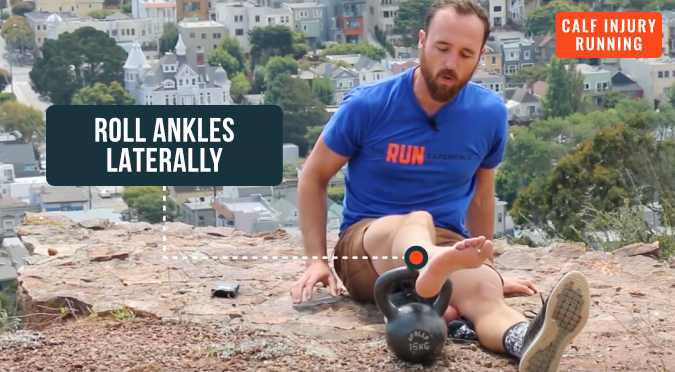
- Grab a kettlebell.
- Sit it on the ground, in front of you with the handle pointed up.
- Now you sit on the ground, with your legs extended in front of you, one of them resting on top of the handle.
- Start with your lower calf on the handle, rolling laterally side to side.
- Add in some ankle circles in both directions.
- After a minute or so in this area, adjust the leg so that the middle of the calf is now resting on the kettlebell handle.
- Repeat the rolling and circles.
- After a minute or so here, repeat everything on the upper part of the calf.
- And of course, repeat ALL of this on the other leg!
One more idea:
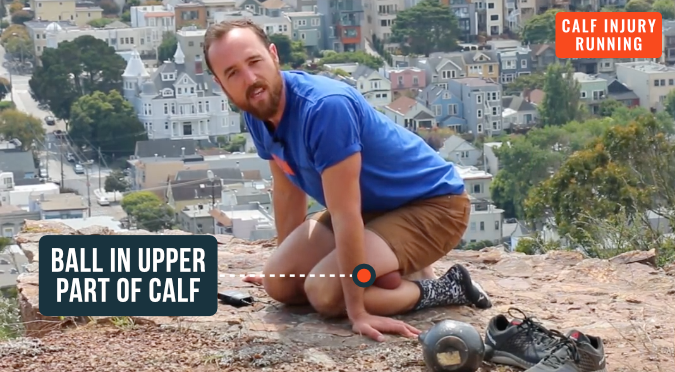
- Grab a yoga tune-up ball, lacrosse ball, or something similar.
- Find a kneeling position on the ground.
- Place the ball just under the hamstring, right between the bulk of the calf and the back of the knee.
- Sit back into your kneeling position, on the ball.
- Spend about two minutes rolling side to side, working into the areas that are tight.
- Repeat everything with the ball on the other leg–this helps to improve blood flow and reduce pain.
- No matter where you FEEL the pain in your calf, there’s a good chance that other tight areas are responsible for contributing.
- Make sure to mobilize through ALL parts of your calves regularly!
How to Prevent Calf Injury
Okay, so we’ve assessed and “fixed” your calf injury. Now, let’s look at how to make sure this won’t happen again…at least if you have a say in it! When it comes to calf injury in runners–we like to use two categories.
The “stiff ankle” runner vs. the “foot collapsing” runner
Let’s take a close look at both.
If any of these are true for you, you may be a “stiff ankle” runner:
Your pain is probably in the low medial area of the calf, close or on the achilles’ tendon. When running, you probably spend most of your time on your forefoot (toes), and your heels rarely touching the ground. *You can have a friend film you running, if you aren’t sure. Running on your toes also causes overuse of your calves and can put you at risk for a stress fracture.
You may not be able to get very low in an air squat position. So, how can you loosen up those ankles for a more relaxed footstrike to reduce muscle strain off the calves?
Try this drill:
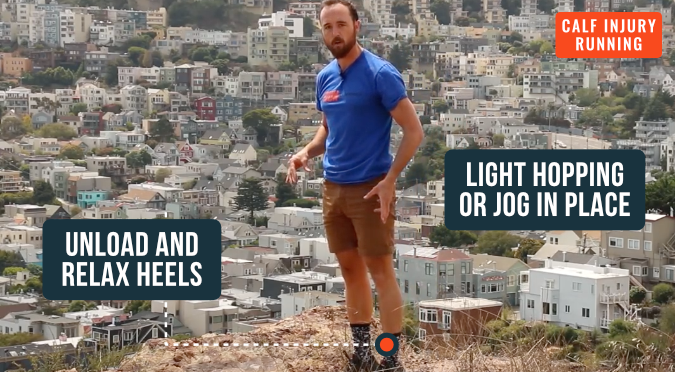
- Start by hopping in place. With each hop, the heels should lightly “kiss” the ground before you push off for the next repetition.
- Once you’ve found a nice rhythm here, start jogging in place.
- Again, making sure the heels are kissing the ground with each step.
- If you’re having trouble here, try shaking out and relaxing the shoulders and taking some big deep breaths.
- Each time your foot pulls of the ground, the ankle should be totally relaxed.
**You can also loosen the ankles up by spending some time at the bottom of your squat. Feel free to rock back and forth, side to side while you’re down there.
Now let’s look at the “foot collapsing” runner:
Your pain is probably on a lateral aspect of the ankle, maybe near the shin. When you run, the arch of your foot repeatedly collapses to the ground with the ankle rolling in, causing leg pain.
You also experience occasional (or regular) pain on the inside of the knee. Chances are good that you’re lacking strength and stability in your hips and ankles.
Try these drills:
- Find tall, engaged position, standing on one leg with the other bent up off the ground.
- Accumulate 3 minutes on both sides.
- To make this more challenging, take the stand into a single leg deadlift. Accumulate 10 per side for 3 rounds.
Another option would be taking the single leg deadlift into a lunge. Again, accumulate 10 per side for 3 rounds.
One more tip:
The foot can’t collapse if it doesn’t have time to do so!
Try increasing your cadence (how many times your foot hits the ground per minute)! Practice jogging in place or on a flat stretch, using a metronome to work up to a cadence of 85-95 steps per foot, per minute.
The quicker you can move your feet, the less time you’ll have to let poor positions creep in and cause calf injury!
How to Help Sore Calves
Now you know how to heal and prevent your sore calves, and that's a fantastic long-term approach. However, what about your sore calves right now? They might be tight and uncomfortable, interfering with everything from your sleep to your day-to-day life.
If you're experiencing pain or just tightness, here are some ideas for how to help sore calves:
- Embrace Rest and Recovery: Ensure to incorporate active rest and designated rest days to facilitate muscle recovery and prevent overstrain.
- Utilize Ice and Heat Therapy: Apply ice to manage inflammation and use heat to relax the muscles and promote blood flow.
- Apply Compression and Elevation: Use compression sleeves to enhance circulation and elevate legs to minimize swelling.
- Engage in Stretching and Strengthening: Implement gentle calf stretches and strengthening exercises to enhance muscle flexibility and resilience.
- Adopt Massage and Foam Rolling: Explore professional massages and utilize foam rolling to alleviate muscle tightness and enhance recovery.
- Find Proper Footwear: Wear supportive running shoes and consider orthotics if you have specific foot or gait issues.
- Prioritize Hydration and Nutrition: Maintain adequate hydration and adopt a balanced diet to support muscle recovery and overall health.
- Adopt Gradual Progression in Training: Ensure any increases in mileage or intensity are gradual and always listen to your body’s signals.
- Explore Alternative Therapies: Consider physical therapy and incorporate practices like yoga to support muscle health and flexibility.
- Evaluate and Adjust Running Form: Consider a gait analysis and make necessary adjustments to your running form to prevent undue stress on the calves.
Get Rid of Sore, Tight Calves From Running for Good
Use this progression, exercises, and assessment tips to best address all calf injuries in runners! Whether you have pain, sore, or tight calves from running, you can control your recovery and bounce back.
Good luck, athletes!
Have you downloaded our new mobile app? It’s loaded with workouts, videos, tips, and advice from expert coaches to keep you motivated every step of the way. Don’t forget to check out our range of training plans for runners of all levels, too!
For sticking with us, enjoy this FREE injury prevention video series. We address all areas of injury in runners, showing you how to treat and prevent from the comfort of your home! Get it HERE!
